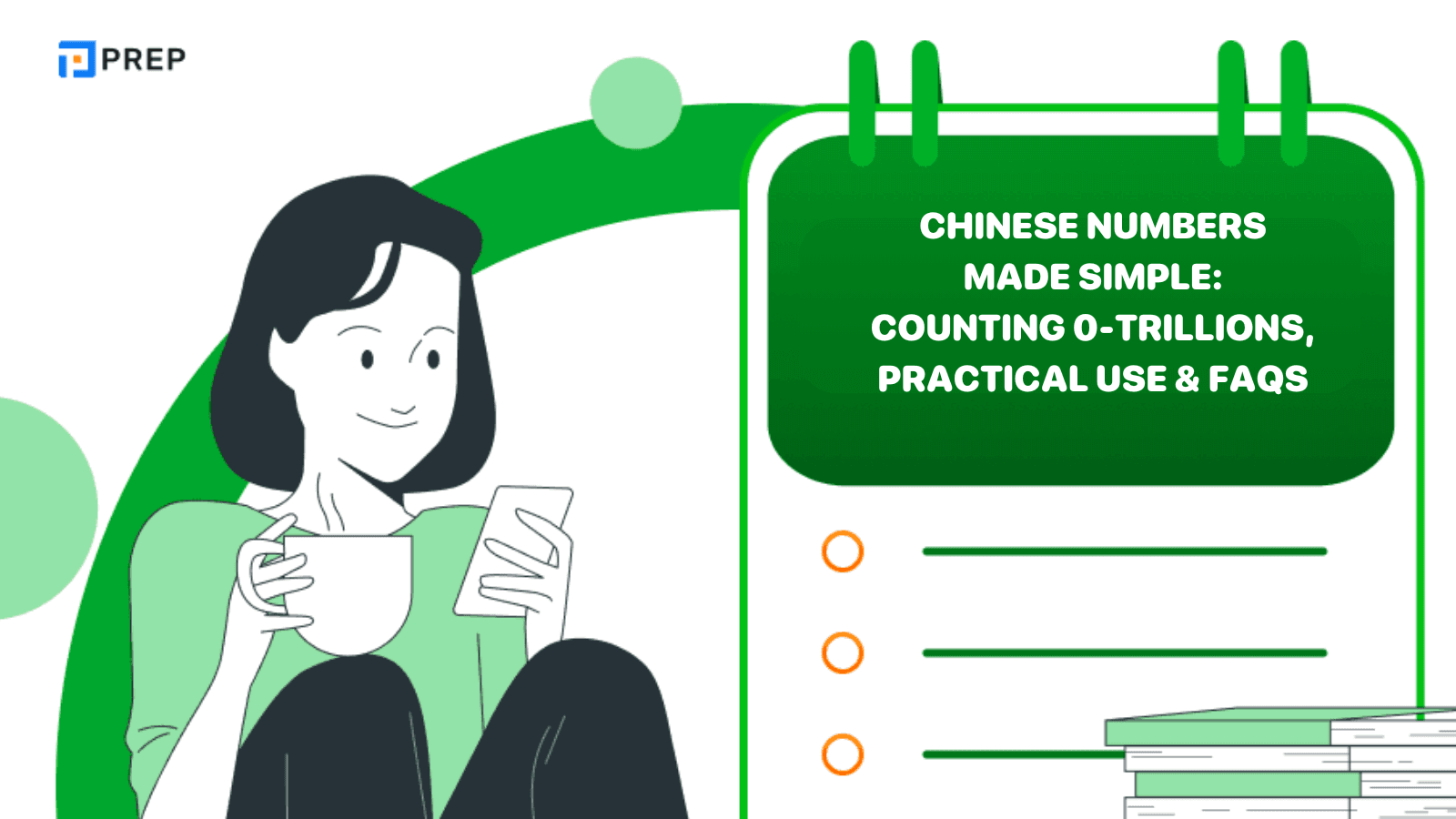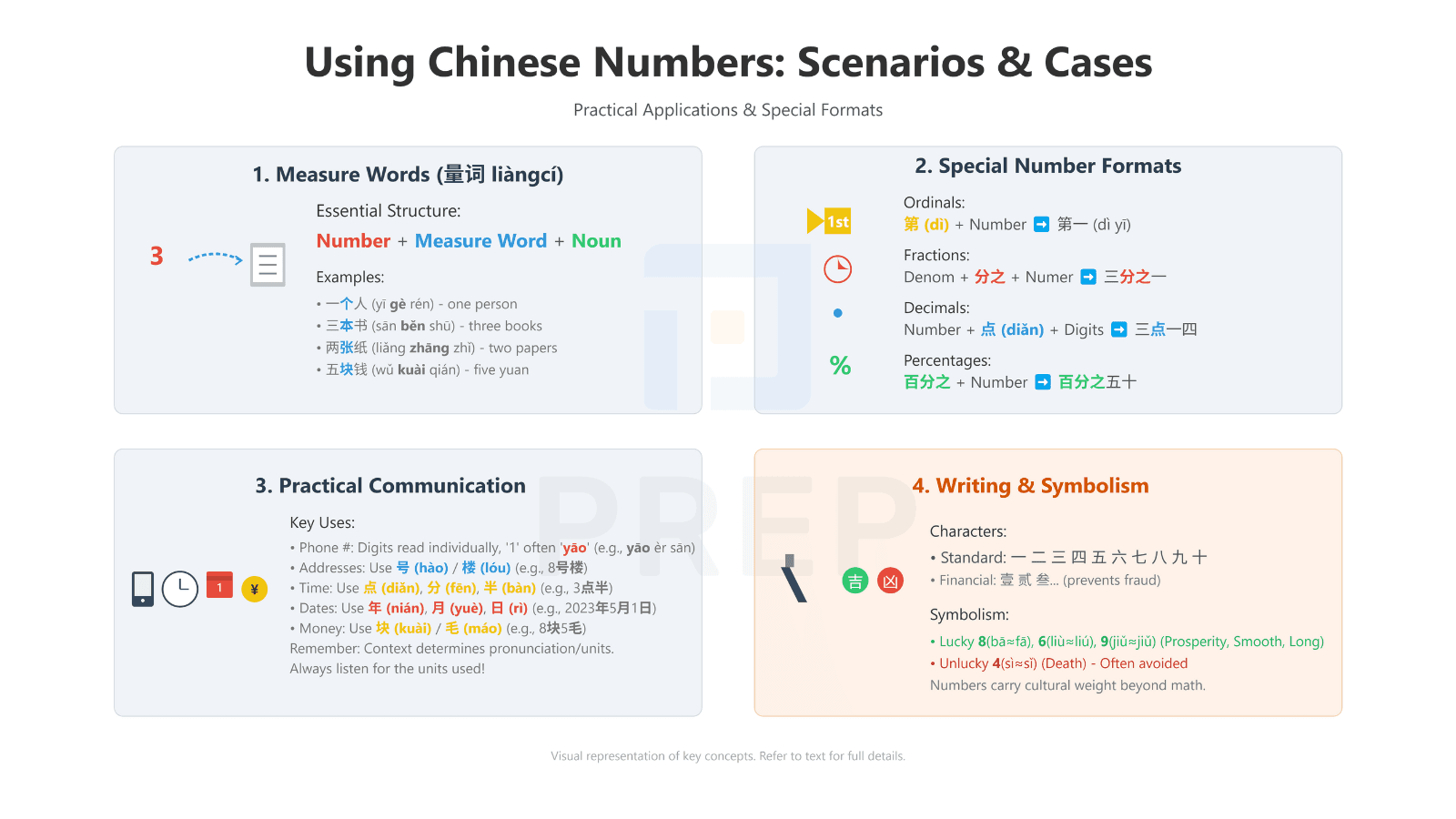Chinese Numbers Made Simple: Counting 0-Trillions, Practical Use & FAQs
Learning Chinese numbers opens the door to everyday conversations, business transactions, and deeper cultural understanding. This comprehensive guide will take you from absolute beginner to confidently handling Chinese numbers in real-world situations. We'll explore the logical system behind Chinese numerals, from basic counting to forming complex figures, along with practical applications and answers to common questions.

I. Counting in Chinese: From Zero (零) to Trillions (兆)
The Chinese numerical system follows a logical structure once you understand its foundation. Unlike Western systems that group by thousands (1,000; 1,000,000), Chinese numbers group by ten-thousands (10,000; 100,000,000), creating an efficient way to express large figures.

1. The Building Blocks: Numbers 0-10 & Key Units
First, let's establish the fundamental Chinese numbers that form the basis of the entire system:
|
Number |
Character |
Pinyin |
English |
|
0 |
零 |
líng |
zero |
|
1 |
一 |
yī |
one |
|
2 |
二 |
èr |
two |
|
3 |
三 |
sān |
three |
|
4 |
四 |
sì |
four |
|
5 |
五 |
wǔ |
five |
|
6 |
六 |
liù |
six |
|
7 |
七 |
qī |
seven |
|
8 |
八 |
bā |
eight |
|
9 |
九 |
jiǔ |
nine |
|
10 |
十 |
shí |
ten |
These fundamental Chinese numbers are combined with key units to form larger values:
|
Unit |
Character |
Pinyin |
Value |
|
Ten |
十 |
shí |
10 |
|
Hundred |
百 |
bǎi |
100 |
|
Thousand |
千 |
qiān |
1,000 |
|
Ten Thousand |
万 |
wàn |
10,000 |
|
Hundred Million |
亿 |
yì |
100,000,000 |
|
Trillion |
兆 |
zhào |
1,000,000,000,000 |
The tones are crucial when pronouncing Chinese numbers. Incorrect tones can lead to confusion, especially with similar-sounding digits like 四 (sì, four) and 十 (shí, ten).
2. Forming Numbers 11-99
Chinese numbers from 11-99 follow straightforward patterns:
For numbers 11-19: The structure is 十 (shí, ten) + number (1-9)
-
11: 十一 (shí yī) = ten + one
-
15: 十五 (shí wǔ) = ten + five
-
19: 十九 (shí jiǔ) = ten + nine
For numbers 20-99: The structure is number (2-9) + 十 (shí, ten) + [number (1-9)]
-
20: 二十 (èr shí) = two + ten
-
28: 二十八 (èr shí bā) = two + ten + eight
-
55: 五十五 (wǔ shí wǔ) = five + ten + five
-
99: 九十九 (jiǔ shí jiǔ) = nine + ten + nine
This pattern creates a logical progression when counting in Chinese numbers, making them easier to memorize than you might initially expect.
3. Hundreds (百) and Thousands (千)
Moving to larger Chinese numbers, we use 百 (bǎi, hundred) and 千 (qiān, thousand) to express values up to 9,999.
The basic structure follows: Number (1-9) + 百/千 + [Lower Units]
For example:
-
100: 一百 (yī bǎi) = one hundred
-
101: 一百零一 (yī bǎi líng yī) = one hundred + zero + one
-
125: 一百二十五 (yī bǎi èr shí wǔ) = one hundred + two tens + five
-
1,000: 一千 (yī qiān) = one thousand
-
1,050: 一千零五十 (yī qiān líng wǔ shí) = one thousand + zero + five tens
Note the use of 零 (líng, zero) when there are internal zeros in the number. This marks the position of zeros between non-zero digits.
For 200 and 2,000, you can use either 二 (èr) or 两 (liǎng):
-
200: 二百/两百 (èr bǎi/liǎng bǎi)
-
2,000: 二千/两千 (èr qiān/liǎng qiān)
While both are correct, 两 (liǎng) is more commonly used before measure words and units like 百, 千, 万, and 亿.
4. Mastering Large Numbers: The 万 (wàn) & 亿 (yì) System
The most distinctive feature of Chinese numbers is the grouping system by ten thousands. Where English uses thousands (1,000; 1,000,000; 1,000,000,000), Chinese uses 万 (wàn, 10,000) and 亿 (yì, 100,000,000) as key markers.
The large number structure works as follows:
-
10,000: 一万 (yī wàn) = one ten-thousand
-
100,000: 十万 (shí wàn) = ten ten-thousands
-
1,000,000: 一百万 (yī bǎi wàn) = one hundred ten-thousands
-
10,000,000: 一千万 (yī qiān wàn) = one thousand ten-thousands
-
100,000,000: 一亿 (yī yì) = one hundred-million
-
1,000,000,000: 十亿 (shí yì) = ten hundred-millions
-
1,000,000,000,000: 一兆 (yī zhào) = one trillion
For complex numbers with internal zeros, 零 (líng) marks the position:
-
10,005: 一万零五 (yī wàn líng wǔ) = one ten-thousand + zero + five
-
10,500: 一万零五百 (yī wàn líng wǔ bǎi) = one ten-thousand + zero + five hundred
For numbers containing multiple twos, 两 (liǎng) is often used with measure units:
-
22,222: 两万两千两百二十二 (liǎng wàn liǎng qiān liǎng bǎi èr shí èr)
This 4-digit grouping system is the key to mastering large Chinese numbers and represents one of the fundamental differences from Western numerical systems.
II. Using Chinese Numbers: Everyday Scenarios & Special Cases
Now that you understand how to form Chinese numbers, let's explore how to use them in practical scenarios, from shopping to telling time and addressing specific numerical formats.

1. Measure Words (量词 liàngcí): Why They're Essential
In Chinese, numbers cannot directly modify nouns as they do in English. Instead, you need a measure word between the number and the noun:
Number + Measure Word + Noun
For example:
-
一个人 (yī gè rén) = one person (个 is the general measure word)
-
三本书 (sān běn shū) = three books (本 is for bound items like books)
-
两张纸 (liǎng zhāng zhǐ) = two sheets of paper (张 for flat objects)
-
五块钱 (wǔ kuài qián) = five dollars/yuan (块 for currency)
-
四位客人 (sì wèi kèrén) = four guests (位 is a respectful measure word for people)
Using the correct measure word is essential for grammatically correct Chinese and shows cultural proficiency. This system has no direct equivalent in English and represents a fundamental difference in how objects are counted.
2. Special Number Formats: Ordinals, Fractions, Decimals, Percentages
Chinese numbers adapt to various formats for different purposes:
Ordinals: Add 第 (dì) before the number
-
First: 第一 (dì yī)
-
Third: 第三 (dì sān)
-
Tenth: 第十 (dì shí)
Fractions: Denominator + 分之 (fēn zhī) + Numerator
-
1/3: 三分之一 (sān fēn zhī yī) = three parts of one
-
3/4: 四分之三 (sì fēn zhī sān) = four parts of three
Decimals: Number + 点 (diǎn) + Digits
-
3.14: 三点一四 (sān diǎn yī sì)
-
5.8: 五点八 (wǔ diǎn bā)
Percentages: 百分之 (bǎi fēn zhī) + Number
-
50%: 百分之五十 (bǎi fēn zhī wǔ shí) = hundred parts of fifty
-
99%: 百分之九十九 (bǎi fēn zhī jiǔ shí jiǔ) = hundred parts of ninety-nine
These formats allow Chinese numbers to express complex mathematical concepts with precision and clarity.
3. Practical Communication: Phone Numbers, Addresses, Time, Dates, Money
Chinese numbers are used differently in various everyday contexts:
Phone Numbers: Digits are read individually, with '1' often pronounced as 'yāo' for clarity
-
123-4567: 一二三,四五六七 (yāo èr sān, sì wǔ liù qī)
Addresses: Structure uses 号 (hào) for numbers, 楼 (lóu) for floors
-
Building 8: 八号楼 (bā hào lóu)
-
Room 305: 三零五房间 (sān líng wǔ fáng jiān)
Time: Uses 点 (diǎn) for hours, 分 (fēn) for minutes, 半 (bàn) for half
-
3:00: 三点 (sān diǎn)
-
3:30: 三点半 (sān diǎn bàn) or 三点三十分 (sān diǎn sān shí fēn)
-
3:15: 三点一刻 (sān diǎn yī kè) or 三点十五分 (sān diǎn shí wǔ fēn)
Dates: Structure with 年 (nián) for year, 月 (yuè) for month, 日/号 (rì/hào) for day
-
May 1, 2023: 二零二三年五月一日/号 (èr líng èr sān nián wǔ yuè yī rì/hào)
Money: Uses units 元/块 (yuán/kuài) for yuan, 角/毛 (jiǎo/máo) for dimes, 分 (fēn) for cents
-
¥8.50: 八块五 (bā kuài wǔ) or 八元五角 (bā yuán wǔ jiǎo)
-
¥3.25: 三块二毛五 (sān kuài èr máo wǔ) or 三元二角五分 (sān yuán èr jiǎo wǔ fēn)
These practical applications of Chinese numbers form the basis of everyday communication and are essential for navigating life in Chinese-speaking environments.
4. Reading and Writing: Chinese number characters & symbolism
The written form of Chinese numbers also carries cultural significance:
The standard Simplified Chinese characters for 1-10 are: 一 (yī), 二 (èr), 三 (sān), 四 (sì), 五 (wǔ), 六 (liù), 七 (qī), 八 (bā), 九 (jiǔ), 十 (shí)
Financial contexts sometimes use special characters to prevent fraud, such as 壹, 贰, 叁 instead of 一, 二, 三.
Chinese numbers also carry cultural symbolism:
-
8 (八, bā) sounds like 发 (fā, prosperity) and is considered extremely lucky
-
6 (六, liù) sounds like 流 (liú, flow) and suggests smoothness or success
-
9 (九, jiǔ) sounds like 久 (jiǔ, long-lasting) and represents longevity
-
4 (四, sì) sounds like 死 (sǐ, death) and is often avoided, similar to how 13 is viewed in Western cultures
Understanding these cultural dimensions helps you navigate the deeper meaning of Chinese numbers beyond their mathematical value.
III. Quick Answers: Frequently Asked Questions (FAQ)
Let's address some common questions about Chinese numbers that learners often ask.
1. Why is '1' sometimes read as 'yāo'?
The digit '1' (一) is typically pronounced "yī", but in sequences like phone numbers, room numbers, or ID numbers, it's often pronounced "yāo" for clarity. This distinction helps prevent confusion with 七 (qī, seven), especially over the phone or in noisy environments. If someone asks for your phone number, pronouncing the ones as "yāo" rather than "yī" will make you sound more natural and be more easily understood.
2. When do I use 两 (liǎng) instead of 二 (èr)?
The distinction between 两 (liǎng) and 二 (èr) is an important nuance in Chinese numbers:
Use 两 (liǎng):
-
Before measure words: 两个人 (liǎng gè rén, two people)
-
When starting units like 百, 千, 万, 亿: 两百 (liǎng bǎi, two hundred)
Use 二 (èr):
-
In sequences like 12, 20, 32: 十二 (shí èr), 二十 (èr shí), 三十二 (sān shí èr)
-
In ordinal numbers: 第二 (dì èr, second)
-
When counting: 一, 二, 三... (yī, èr, sān...)
Understanding this distinction will make your Chinese sound more natural and refined.
3. What's the biggest challenge with large Chinese numbers?
The most significant hurdle for learners of Chinese numbers is adapting to the 万 (wàn)/亿 (yì) system that groups by 10,000s rather than 1,000s. This fundamental difference means that large numbers don't translate directly between English and Chinese. For example, 1,000,000 isn't "one million" but "one hundred ten-thousands" (一百万, yī bǎi wàn). This mental regrouping requires practice but eventually becomes second nature with regular use.
4. How important are tones when saying numbers?
Tones are crucial when pronouncing Chinese numbers. Consider these potentially confusing pairs:
-
四 (sì, fourth tone) vs. 十 (shí, second tone)
-
一 (yī, first tone) vs. 七 (qī, first tone)
Without correct tones, "14" (十四, shí sì) might be misheard as "40" (四十, sì shí). In contexts like prices, addresses, or important quantities, tonal accuracy prevents costly misunderstandings and demonstrates language proficiency.
5. Do I really need measure words every time?
Yes, measure words are generally required when counting nouns in Chinese. Unlike English where you can say "five books" directly, Chinese requires "five [measure word] books" (五本书, wǔ běn shū). This grammatical structure is fundamental, not optional. The only exceptions are when you're counting abstractly (just saying numbers in sequence) or in specific contexts like mathematical operations. Using measure words correctly reflects basic grammatical competence in Chinese.
IV. Summary & Next Steps
1. Key Takeaways for Chinese Numbers
The Chinese number system follows logical patterns that make it accessible once you understand its structure:
-
Master the basics (0-10) and key units (十, 百, 千, 万, 亿)
-
Follow the combination rules for numbers 11-99 using the ten (十) unit
-
Understand the 万/亿 system that groups by 10,000s, not 1,000s
-
Remember the 二 (èr)/两 (liǎng) distinction for different contexts
-
Use 零 (líng) to mark internal zeros in complex numbers
-
Always include appropriate measure words when counting objects
-
Use 'yāo' instead of 'yī' for clarity in sequences like phone numbers
-
Be aware of cultural associations, especially lucky 8 and unlucky 4
These fundamentals provide a strong foundation for using Chinese numbers effectively in various contexts.
2. Practice Makes Perfect
The best way to master Chinese numbers is through consistent practice in real-world contexts. Start by reading prices while shopping, telling time, counting objects around you, or reciting phone numbers. Each practice session strengthens your numerical fluency.
At PREP, we provide structured learning paths that incorporate number usage into practical language skills. Our courses guide you from basic counting to confident numerical communication across various contexts and scenarios.
Remember that Chinese numbers follow logical patterns. Once you grasp the underlying structure, you'll find yourself counting effortlessly from zero to trillions. The system's elegance reveals itself through practice, ultimately becoming one of the more straightforward aspects of Mandarin Chinese.

Hi I'm Chloe, and I am currently serving as an Product Content Administrator at Prep Education. With over five years of experience in independent online IELTS study and exam preparation, I am confident in my ability to support learners in achieving their highest possible scores.
Comment
Premium content
View allPersonalized roadmap
Most read












